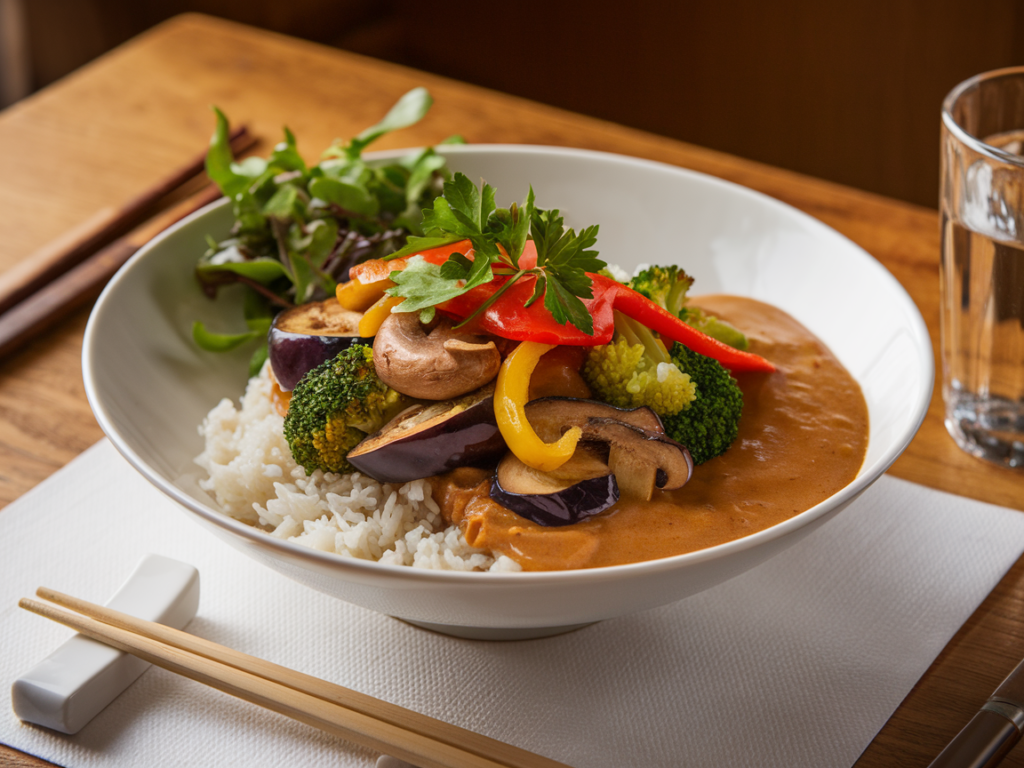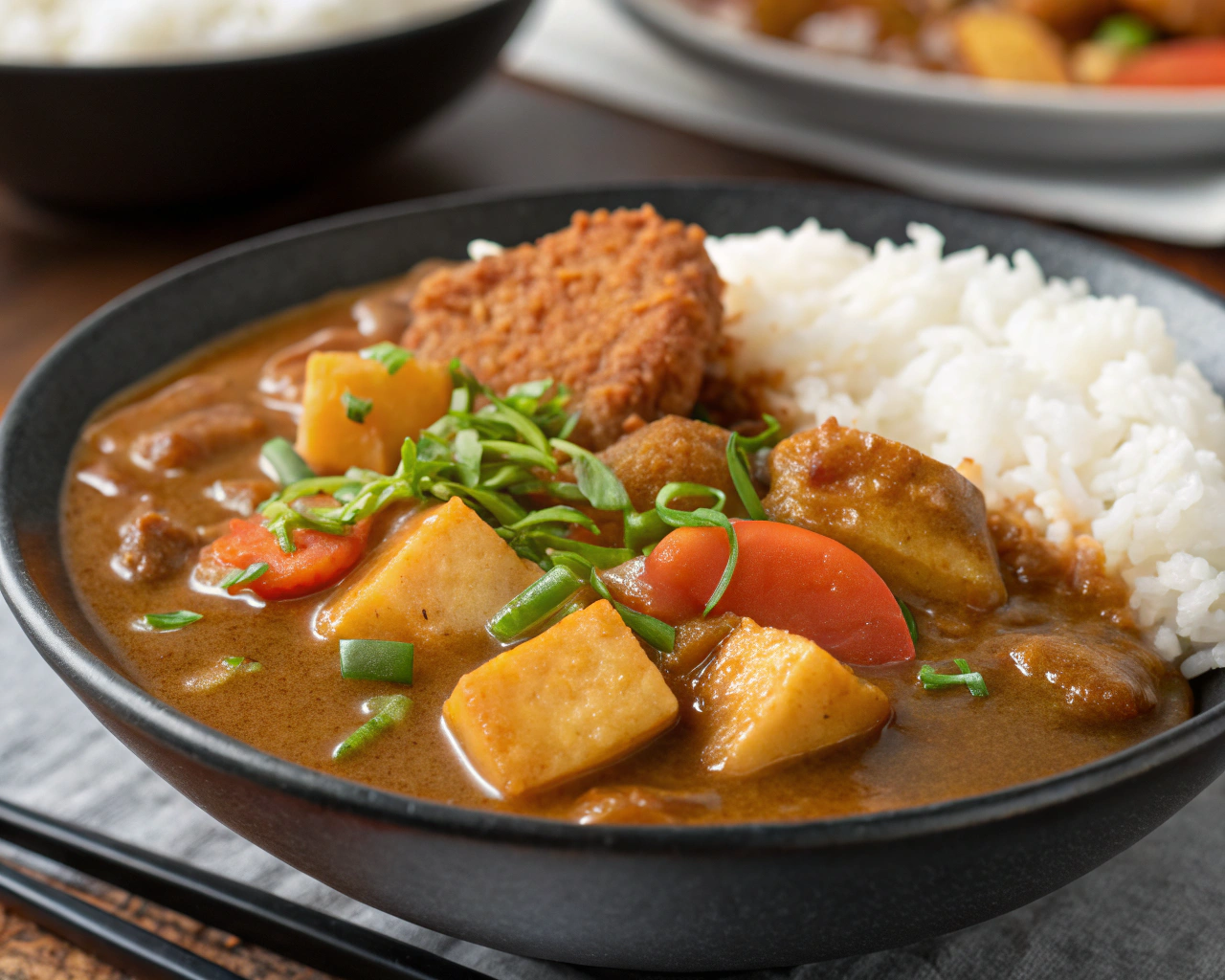Coco Ichibanya, widely known as Coco Curry, is one of Japan’s most popular curry chains, famous for its customizable curry dishes. With the growing global trend of plant-based diets, many customers wonder if Coco Curry offers vegan-friendly options. While traditional Japanese curry often contains animal products, Coco Curry has made strides to cater to the vegan and vegetarian community.
This article explores Coco Curry’s vegan offerings, tips for ordering vegan dishes, and how it compares to other curry chains. For more ideas on plant-based customization, check out how to customize plant-based meals.
Table of Contents
What Is Coco Curry?
A Brief History
Coco Ichibanya, which originated in Japan, has rapidly grown to become one of the largest and most beloved curry chains in the world. Renowned for its extensive customization options, Coco Curry offers diners the unique opportunity to tailor their meals to their exact preferences. Customers can select their preferred curry base, adjust the spice level to suit their taste, and choose from a variety of toppings to create their ideal dish. This high level of personalization has made Coco Ichibanya a favorite among families, travelers, and curry enthusiasts alike. Whether you prefer a mild, creamy curry or a fiery, spice-packed bowl, Coco Curry’s flexible menu ensures there’s something for everyone. Its ability to cater to diverse tastes and dietary needs has solidified its reputation as a go-to destination for curry lovers around the globe.
Global Expansion
With branches in countries like the United States, Thailand, and the Philippines, Coco Curry has successfully expanded its reach beyond Japan, adapting its menu to suit local tastes and preferences. This global expansion has allowed the chain to introduce its signature customizable curry experience to a wider audience while incorporating regional flavors and ingredients. For example, in the United States, Coco Curry might offer heartier portions or bolder spice levels, while in Thailand, the menu could feature lighter, more aromatic curry bases that align with local culinary traditions. Similarly, in the Philippines, the chain might incorporate sweeter or tangier elements to cater to the local palate.
As part of this adaptation, Coco Curry has also responded to the growing demand for vegan-friendly options, reflecting the global rise in plant-based eating. Many locations now offer plant-based curry bases, such as vegetable or coconut milk-based sauces, and a variety of vegan toppings like tofu, mushrooms, and seasonal vegetables. This shift not only broadens the chain’s appeal but also ensures that it remains inclusive and accessible to a diverse customer base, including those following vegan or vegetarian diets. By embracing these changes, Coco Curry continues to innovate while staying true to its core philosophy of customization and quality, making it a beloved choice for curry lovers worldwide.
Vegan-Friendly Menu at Coco Curry
1. Curry Base
The first thing to check when ordering vegan at Coco Curry is the curry roux. In Japan, the standard curry base often contains animal-derived ingredients such as beef or chicken stock. However, some locations offer a vegan curry base explicitly labeled for plant-based diners.
2. Toppings
- Plant-Based Toppings:
- Seasonal vegetables
- Mushrooms
- Eggplant
- Tofu
- Avoid:
- Toppings like sausages, meat cutlets, or eggs that may contain animal products.
3. Rice and Sides
The standard white rice served with Coco Curry is naturally vegan-friendly, making it a safe and satisfying base for your customized curry dish. Its simplicity and versatility allow it to pair perfectly with any curry base, whether it’s a rich and creamy coconut curry or a spicy tomato-based sauce. For side dishes, diners can opt for a fresh green salad, which is often available on the menu. To ensure the meal remains fully vegan, it’s important to choose a vegan-friendly dressing, such as a simple vinaigrette or olive oil and lemon combination. These light and refreshing sides complement the bold flavors of the curry while adding a healthy, plant-based touch to the meal. By making mindful choices, vegan diners can enjoy a complete and delicious dining experience at Coco Curry.
4. Regional Variations
International branches of Coco Curry often excel in providing better vegan labeling and a wider range of plant-based options, catering to the increasing demand for vegan-friendly meals. For instance, locations in the United States and Thailand are more likely to feature clearly marked vegan curry bases and toppings, reflecting the strong influence of the growing plant-based movement in these regions. In the U.S., where veganism has gained significant traction, Coco Curry may offer bases like vegetable or coconut milk-based curries, alongside toppings such as tofu, mushrooms, and seasonal vegetables. Similarly, in Thailand, where plant-based eating is also on the rise, the menu might include lighter, aromatic curry bases made with locally inspired ingredients, ensuring they align with both vegan preferences and regional flavors.
This focus on vegan-friendly options in international branches highlights Coco Curry’s commitment to inclusivity and adaptability. By clearly labeling vegan items and expanding their plant-based offerings, the chain makes it easier for vegan diners to enjoy their meals without hesitation. This approach not only enhances the dining experience for those following a plant-based lifestyle but also positions Coco Curry as a forward-thinking brand that embraces global culinary trends. Whether you’re in the U.S., Thailand, or elsewhere, these international branches demonstrate how Coco Curry continues to innovate and cater to the evolving tastes and dietary needs of its diverse customer base.
How to Order Vegan at Coco Curry
1. Ask Questions
- Always confirm with the staff whether the curry roux and toppings are vegan. Don’t hesitate to inquire about the cooking methods, as some dishes may involve cross-contamination.
2. Use Customization Options
- Coco Curry’s unique customization system allows you to create your dish by selecting only vegan-friendly components. Combine the vegan curry base with plant-based toppings and rice for a satisfying meal.
3. Look for Vegan Labels
- Some branches explicitly label vegan dishes, making it easier to identify safe options.
4. Confirm Cooking Methods
- To avoid cross-contamination, ask if vegan dishes are prepared separately from non-vegan items.
Comparisons with Other Curry Chains
1. Go! Go! Curry
- Go! Go! Curry, while popular for its hearty and flavorful dishes, offers fewer vegan options compared to Coco Curry. While their menu includes vegetarian curries, which may exclude meat, they often still contain dairy or other animal-derived ingredients, making them unsuitable for a fully vegan diet. For those seeking a vegan meal, customization is often necessary. Diners may need to request modifications, such as omitting dairy-based sauces or toppings and substituting them with plant-based alternatives like extra vegetables or tofu. Additionally, it’s important to confirm with staff about the ingredients used in the curry base and sauces to ensure they align with vegan standards. While Go! Go! Curry may not be as vegan-friendly as Coco Curry, with a bit of effort and clear communication, it’s still possible to enjoy a satisfying plant-based meal at their locations.
2. Curry House
- Curry House chains, particularly those in international locations, have been making strides in introducing more vegan options to their menus, reflecting the growing demand for plant-based dining. Many of these chains now provide clear labeling and even dedicated vegan-specific menu sections, making it easier for diners to identify and choose suitable dishes. This shift is especially noticeable in regions where veganism and plant-based eating have gained significant popularity, such as the United States, Europe, and parts of Asia.
- For example, some Curry House locations offer vegan curry bases made with coconut milk, vegetable broth, or tomato-based sauces, ensuring they are free from animal-derived ingredients like dairy or meat stocks. Toppings such as tofu, chickpeas, lentils, and a variety of fresh vegetables are often available to create a fully vegan meal. Additionally, sides like steamed rice, naan made without dairy, and vegan-friendly salads are commonly offered to complement the main dish.
- By incorporating these changes, Curry House chains are not only catering to the needs of vegan diners but also aligning themselves with broader global trends toward sustainable and ethical eating. This commitment to inclusivity and transparency in menu labeling helps create a more welcoming dining experience for everyone, regardless of dietary preferences. Whether you’re a long-time vegan or simply exploring plant-based options, Curry House’s evolving menu offers a delicious and accessible way to enjoy the rich flavors of curry.
Challenges in Finding Vegan Options at Coco Curry
1. Limited Awareness
In Japan, the concept of veganism is not as widely understood as in Western countries. This can make it difficult to explain dietary restrictions.
2. Cross-Contamination
While some branches take precautions, shared equipment and cooking spaces may pose a challenge for strict vegans.
3. Regional Inconsistencies
The availability of vegan options varies by location, with international branches generally offering more comprehensive plant-based choices.
Benefits of Vegan Options at Coco Curry
1. Health Benefits
- Lower in saturated fats compared to meat-based dishes.
- Rich in vegetables, providing essential nutrients and fiber.
2. Environmental Impact
- Vegan meals typically have a smaller carbon footprint, aligning with sustainable eating practices.
Frequently Asked Questions (FAQs)
Q1: Is the curry roux at Coco Curry vegan?
Some branches offer a vegan curry roux, but the standard version often contains animal products. Always confirm with the staff.
Q2: Can I customize my curry to be vegan?
Yes, Coco Curry’s menu is highly customizable, allowing you to create a fully vegan dish with a vegan curry base, rice, and plant-based toppings.
Q3: Are there vegan desserts at Coco Curry?
Vegan dessert options are limited. However, international branches may occasionally offer plant-based treats.
Q4: How do international branches differ in vegan offerings?
International locations often have clearer vegan labeling and a wider selection of vegan options compared to Japanese branches.
Q5: Can I trust the vegan labels at Coco Curry?
While most labels are reliable, it’s always best to confirm with the staff to ensure ingredients and preparation methods meet vegan standards.
Internal Linking Opportunities
- Vegan Dining Out
- Customizing Plant-Based Meals
- Vegan Japanese Recipes

Conclusion
Coco Curry offers a customizable dining experience that can accommodate vegan diets, though the availability of options varies by location. By asking the right questions, utilizing their customization options, and understanding the menu, you can enjoy a delicious vegan meal at this popular curry chain. With the rise of plant-based eating, Coco Curry’s efforts to expand its vegan offerings are a step in the right direction.
For those looking to explore more vegan-friendly dining options, resources like HappyCow and Veganuary provide helpful guides and restaurant recommendations. Additionally, if you’re interested in making your own plant-based Japanese-style curry, Most Liked Recipes offers a variety of vegan recipes to try at home.
Whether dining out or cooking at home, embracing plant-based eating has never been more accessible!

